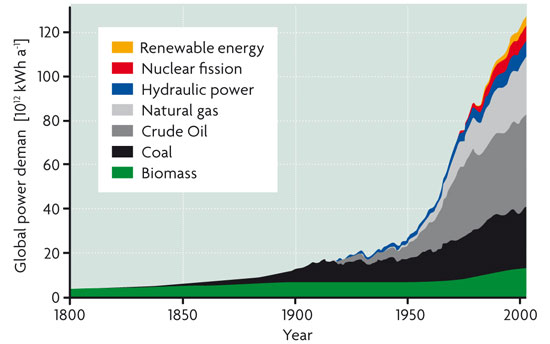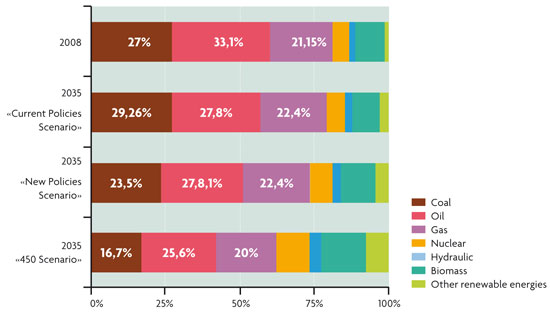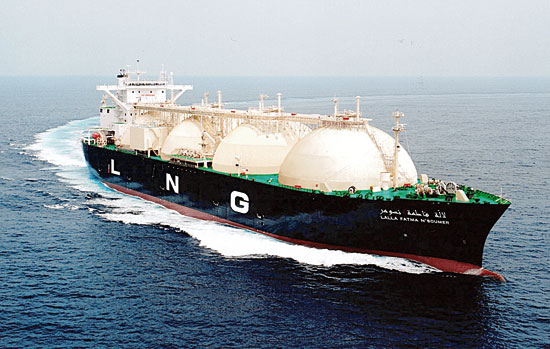 © BP Offshore platforms demonstrate the level of sophistication achieved by this kind of mining, as well as the difficulties faced due to the progressive depletion of deposits within easy reach. The picture shows a BP platform off Trinidad and Tobago. |
||
|
Our society’s progress owes a great deal to fossil fuels, which were crucial to the industrial revolution. However, their finite availability, and the increasingly difficulty of extracting them makes it more imperative than ever to rethink their use. |
||
|
Before the Industrial Revolution, the development of human societies was limited by the rate at which they were able to take advantage of solar radiation, and its influence on changing our planet. For the greater part of human history, food and fuel production was limited by low efficiency photosynthesis, and by an insufficient supply of nutrients to plants. Average crop yields were low, which caused chronic malnutrition and recurring famines. Energy storage was severely curtailed by the low energy density of biomass –about four kilowatts/hour (kWh) per kg of straw and between 4 and 4.7 per kg of wood– while the specific power of the main drivers was less than 0.1 kilowatts (kW) of sustained power for humans, and 0.5 kW for draught animals. Even so, ancient societies were able to gradually increase the per capita use of energy, making use of water and wind and gathering increasing labour force, mainly comprising slaves and animals. The fossil fuel revolution The large-scale extraction and combustion of fossil fuels meant a fundamental change in the type and intensity of energy use. These compounds (coal, oil and gas) cover a very broad spectrum of organic molecules, generated by a complex and lengthy process. This implies very slow transformation, for periods lasting between 100 thousand to 100 million years, during which organic matter is synthesised in the biosphere and then stored as animal and plant detritus at the bottom of sedimentary basins (lakes, seas and oceans). Subsequently, it is buried under successive layers of sediment, subjected to the combined action of high pressures and heat generated by the decay of radioactive elements in the earth’s crust. Thus, by the process described, Mother Nature can store solar energy in chemical bonds of hydrogen and carbon atoms that make up the molecules forming fossil fuels. For millennia, humans have obtained food, heat and the mechanical power they need to survive from solar radiation and from its almost immediate transformation (water and wind flows), and from energy provided by metabolic conversion and biomass produced within months, a few years or, at most, a few decades. By contrast, fossil fuels, with the exception of peat, are the result of intensive biomass changes during geological periods. Using an economic analogy, we could consider that the development of pre-modern societies depended on solar income, either instant or minimally delayed, which was constantly replenished. By contrast, modern civilization owes its splendour to the use of its solar heritage; wealth we are squandering at high speed and which, ultimately, we will have enjoyed for just a small fraction of the time it took to accumulate. Preindustrial societies were, in theory, energetically sustainable on a time-sale of thousands of years, although in practice many of them compromised their development by excessive deforestation and soil erosion. By contrast, modern civilization is based on the unquestionably unsustainable use of a unique solar heritage that cannot provide a solution on the timescale of a civilization. But this heritage has given us access to highly concentrated and easily stored energy resources, which have been used at an ever increasing rate. The use of fossil fuels has enabled humans to overcome the power consumption limits imposed by the low efficiency of photosynthesis and low yields of water flow and air currents. As a result, overall energy consumption has increased to unprecedented levels. |
«Mother Nature can store solar energy in chemical bonds of hydrogen and carbon atoms that make up the molecules forming fossil fuels» |
|
 © Russell Lee Large-scale coal mining helped boost our industrial civilization. Along with oil and natural gas, coal is still widely used, despite the associated environmental problems. The picture shows American miners in the 1940s. |
«The question is not the quantity of the reserves and resources secreted in the depths of our planet, but rather whether we can extract them at an efficient rate and price» |
|
|
A breakdown of the global consumption of primary energy (biomass, fossil fuels, renewables and nuclear) shows a rise from just over 10 exajoules (10 EJ = 10 × 1018 joules or 2.778 × 1012 kilowatt-hours (kWh)) in the year 1750 to nearly 20 EJ one century later, subsequently reaching 45 EJ in 1900, almost 100 EJ in the middle of the last century and, finally, exceeding 400 EJ at the beginning of this century. Even though during the twentieth century the world population increased by about factor four (1,600 to 6,100 million), the overall average annual consumption of primary energy per capita doubled from 28 to 65 × 109 joules (from 7,778.4 to 18,057 kWh), while the average annual consumption of fossil fuels per capita increased over four times. And these figures are even more impressive if expressed in terms of useful energy. Constant technical advances have improved the average efficiencies of all commercial energy conversions, many by an order of magnitude. Indeed, further breakdown of energy services (heating, cooling, lighting, motion…) provides an even more accurate picture of the growth experienced by the global energy flow than the simple measurement of primary energy inputs. The current demand for fossil fuels In 2008, fossil fuels accounted for 81.25% of all primary energy consumed worldwide. This percentage was distributed as follows: coal 27%, oil 33.1% and gas 21.15% and future projections indicate that this dominance of fossil fuels will continue in the coming decades. Thus, in its latest report on the global energy scenario (World Energy Outlook 2011),the International Energy Agency (IEA) considered three scenarios for trends in world primary energy demand up until 2035. The first, called «Current Policies Scenario» projects where current policies will lead, and foresees a slight decline, down to 79.46%, in the percentage that fossil fuels would represent in the global energy mix (coal 29.26%, oil 27.8%, and gas 22.4%). This would entail a 45.4% increase in CO2 emissions over current levels, and a rise in average global temperatures of more than 3.5°C. The second, called «New Policies Scenario » assumes that all commitments and plans announced by governments with respect to reducing greenhouse gases, as well as the elimination of subsidies for fossil fuels, will be fulfilled. Notwithstanding, fossil fuels would still represent 73.7% of the overall (coal 23.5%, oil 27.8% and gas 22.4%) in 2035, which would imply an increase of 21% in CO2 emissions and a rise of about 3.5°C in the Earth’s average temperature. The third is called the «450 Scenario» because it presupposes that governments will adopt a range of drastic measures limiting the concentration of greenhouse gases in the atmosphere to around 450 parts per million of CO2, This would mean, with a likelihood of 50%, that average global temperatures would not increase by more than 2°C. However, even in this scenario, the percentage of fossil fuels in the global energy mix would be 62.3% (coal 16.7%, oil 25.6% and gas 20%). |
||
 Trends in world energy demand during the 1800-2000 period. It highlights the upward turn the curves take after 1950 and the important role of fossil fuels, thanks to which overall energy consumption increased fivefold over the second half of the twentieth century. Trends in world energy demand during the 1800-2000 period. It highlights the upward turn the curves take after 1950 and the important role of fossil fuels, thanks to which overall energy consumption increased fivefold over the second half of the twentieth century. |
|
|
|
Unpredictable future Given such forecasts on the unremitting use of fossil fuels, we should consider the availability of reserves and resources. The general consensus is that they are sufficient to meet demands in the coming decades. According to BP, at current rates of consumption, known oil, gas and coal reserves will last around 46, 59 and 118 years, respectively. However, this does not imply a problem-free future, since the unpredictable factor is not the quantity of the reserves and resources secreted in the depths of our planet, but rather whether we can extract them at an efficient rate and price. In fact, a report by the National Petroleum Council warns of a disquieting truth: «The world is not running out of energy resources, but there are accumulating risks to continuing expansion of oil and natural gas production from the conventional sources relied upon historically. These risks create significant challenges to meeting projected total energy demand». What is the exact meaning of this statement? What risks does it refer to? Some are technical in nature. Since the nineteen-eighties and nineties, the discovery of new conventional hydrocarbon reserves do not keep up with the volumes being extracted; furthermore, exploration and production costs are rising as work increasingly takes place in more remote regions and in extreme environments, and requires deeper drilling. Moreover, global production of conventional oil and gas in currently operating reserves is experiencing an average annual decline of 6.7%, which could reach 10% if investments fall off. Besides, the oil industry suffers alarming staff shortages, and the correlation between energy obtained from the extracted oil and energy used in the extraction process is rapidly deteriorating. Therefore each new barrel added to the alleged reserves has a lower net energy content. In addition to these technical problems, there are others of clearly geopolitical nature and implications, related to the fact conventional reserves are all located in just a few countries. And, to the above, one must add the uncertainties surrounding the investments that are necessary to increase production. The main obstacles that could limit or delay such investments are essentially of a geopolitical kind. These include: policies to control resource extraction rates imposed by governments; «petro-nationalism», preventing or limiting the access to and exploitation of resources by private international companies; political instability, involving the threat of terrorism or military conflicts, which often go hand in hand with the so-called «natural resource curse». |
||
 Different estimates of the distribution of world primary energy demand according to the International Energy Agency. The future energy mix varies according to different possible scenarios: «Current Policies Scenario» projects where current policies will lead; «New Policies Scenario » assumes commitments and plans announced by governments will be met; «450 Scenario» presupposes that governments will adopt a range of drastic measures to limit CO2 emissions into the atmosphere. In any event, fossil fuels will continue to play an important role in the coming decades. Different estimates of the distribution of world primary energy demand according to the International Energy Agency. The future energy mix varies according to different possible scenarios: «Current Policies Scenario» projects where current policies will lead; «New Policies Scenario » assumes commitments and plans announced by governments will be met; «450 Scenario» presupposes that governments will adopt a range of drastic measures to limit CO2 emissions into the atmosphere. In any event, fossil fuels will continue to play an important role in the coming decades. |
«In 2008, fossil fuels accounted for 81.25% of all primary energy consumed worldwide and future projections indicate that this dominance will continue in the coming decades» |
|
|
The above considerations relate primarily to conventional energy reserves and resources, namely oil and gas. They include those that can be extracted using traditional techniques, applicable to hydrocarbons, which flow with relative ease due to the pressure gradient between subsurface and surface after the well has been drilled. However, in order to diminish some of the abovementioned drawbacks, these industries are increasingly turning to the exploitation of so-called unconventional resources. These include extraction methods using techniques ranging from traditional mining to the injection of hot water or water at high pressures to crack rocks. Unconventional hydrocarbons encompass a wide range of liquid, semi-liquid or viscous substances, known as non-conventional oils, among which are the Canadian oil sands or tar sands, Venezuelan extra-heavy oils, or the oil shales found in many parts of the world. They also include gaseous substances, known as unconventional gas, including shale gas, coal bed methane and tight gas, from low permeability rock formations. Gas hydrates are not included within the latter type of unconventional gas resources, as yet. These are natural solids, with a frozen snow-like appearance, characterised by a cage-like structure, formed by a crystalline lattice of water molecules trapping gaseous hydrocarbon molecules, mainly methane, inside. Within this «icy cage» methane molecules are compressed by a factor of around 164, so that at atmospheric pressure and temperature, one cubic meter of gas hydrate releases 164 cubic meters of gas and 0.8 cubic metres of water. This concentration factor means sediments containing gas hydrates are of special relevance, both in terms of energy potential, and from the perspective of geological hazards and climate change. Gas hydrates are stable under conditions of moderately high pressure and moderately low temperature. These conditions are to be found both on land, in permafrost of the Arctic regions, as well as in sediments located in the deep ocean or other large expanses of water, such as inland seas. In number, they could duplicate that of known reserves of oil, coal and natural gas together. But today, access to these gas hydrates is extremely complex and there is no effective method to extract energy from them. The main difficulty is that these solid compounds are unstable under normal pressure and temperature conditions, and consequently gas escapes into the atmosphere if we try to recover it using surface mining techniques. Moreover, extraction of gas using probe techniques after hot water injection is generally hindered by the low permeability of sediments containing gas hydrates, which are usually found in nodules or discontinuous accumulations. Unconventional hydrocarbons expand potential oil and gas availability, with the added advantage of their geographical distribution, diminishing the geopolitical problem of conventional reserves concentrated in the Middle East and Russia. However, despite technological progress and cost reduction, unconventional hydrocarbons are more expensive to extract and their use causes major environmental impact and generates more greenhouse gas emissions. Also, to obtain them implies an energy balance (ratio between the energy produced and that used in the production process) around ten times lower than that of conventional hydrocarbons. There problems should certainly be borne in mind when pondering on the future of fossil fuels |
||
 © Iberdrola Gas is transported through pipelines or in special ships after being liquefied. The liquefaction process can reduce gas volume by up to 600 times. |
«Unconventional hydrocarbons are more expensive to extract and their use causes major environmental impact and generates more greenhouse gas emissions» |
|
|
Drawing conclusions Fossil fuels have enabled our society to make major progress and were crucial to the industrial revolution. However, their finite availability, coupled with the increasing difficultly of extracting them, makes it more essential than ever to rethink how we use them and spark an energy revolution. I am not exaggerating. This is not a new energy transition, but a revolution in the making. To appreciate the magnitude of the challenge we face, we only have to compare the demand for fossil fuels needed in the past to replace biomass, with the expected demand for non-fossil fuels (renewable and nuclear) that would be needed in the future to replace oil, gas and coal. In fact, in the late 1890s, when the amount of energy from biomass fell just below 50% of the total supply of primary energy in the world, it took around 20 EJ (5.556 × 1012 kWh) of additional supply of fossil fuels to replace the entire consumption provided by the biomass that was replaced. However, in 2010, the world was using fossil fuels at an annual rate of close to 400 EJ, which means that the new supplies of non-fossil energy needed to replace coal, oil and gas is 20 times greater than the energy required during the aforementioned transition. Furthermore, a historical analysis of the rate at which changes have occurred in the use of fuels shows that once coal, oil and gas had reached 5% of total energy production, we still had to wait 35, 40 and 55, years respectively, for these fossil fuels to make up 25% of the energy market. |
||
Bibliography
BP, 2011. BP Statistical Review of World Energy June 2011. BP. London.
International Energy Agency, 2011. World Energy Outlook 2011. OECD. Paris.
NPC, 2007. Facing the Hard Truths about Energy. National Petroleum Council. Washington.





